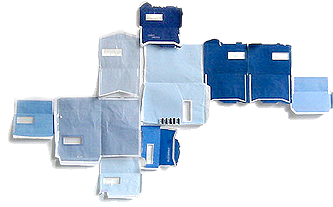
Dr. E. J. Marey – Chronographic image of a man in black clothes with a white stripe on the side walking past a black wall. 1884. From ‘Uit De Geschiedenis van De Fotografie’ p.132
Having read and been inspired by J. G. Ballard’s description of ‘Marey’s Chronograms’ (shouldn’t that be ‘Chronographs’?) in ‘The Atrocity Exhibition’, I assumed this was a clever Ballardian concept.
A couple of weeks ago, leafing through a flea market find ‘Uit De Geschiedenis van De Fotografie’ [From the History of Photography], I was surprised to to see an actual Chronograph made by Étienne-Jules Marey.

Dr. E. J. Marey – Chronographic image of movement phases of flexible reed. 1884 (The man is probably Marey). From ‘Uit De Geschiedenis van De Fotografie’ p.133
I was aware of Eadweard Muybridge and his motion photography, but had never heard or seen anything by Marey, who’s work pre-dates Muybridge.
From Muybridge’s wikipedia entry:
“Recent scholarship has pointed to the influence of Étienne Jules de Marey on Muybridge’s later work. Muybridge visited Marey’s studio in France and saw Marey’s stop-motion studies before returning to the U.S. to further his own work in the same area.
From ‘The Atrocity Exhibition’ – Marey’s Chronograms
 Dr. Nathan passed the illustration across his desk to Margaret Travis. ‘Marey’s Chronograms are multiple-exposure photographs in which the element of time is visible – the walking human figure, for example, is represented as a series of dune-like lumps.’
Dr. Nathan passed the illustration across his desk to Margaret Travis. ‘Marey’s Chronograms are multiple-exposure photographs in which the element of time is visible – the walking human figure, for example, is represented as a series of dune-like lumps.’
Dr Nathan accepted a cigarette from Catherine Austin, who had sauntered forward from the incubator at the rear of the office. Ignoring her quizzical eye, he continued, ‘Your husband’s brilliant feat was to reverse the process.
Using a series of photographs of the most commonplace objects – this office, let us say, a panorama of New York skyscrapers, the naked body of a woman, the face of a catatonic patient – he treated them a if they already were chronograms and extracted the element of time.’
Dr Nathan lit his cigarette with care. ‘The results were extraordinary. A very different world was revealed. The familiar surroundings of our lives, even our smallest gestures, were seen to have totally altered meanings. As for the reclining figure of a film star, or this hospital…’
J.G. Ballard – The Atrocity Exhibition p.6
From the notes, p16:
‘An Individual is a four-dimensional object of greatly elongated form; in ordinary language we say that he has considerable extension in time and insignificant extension in space.’ Eddington, Space, Time and Gravitation

